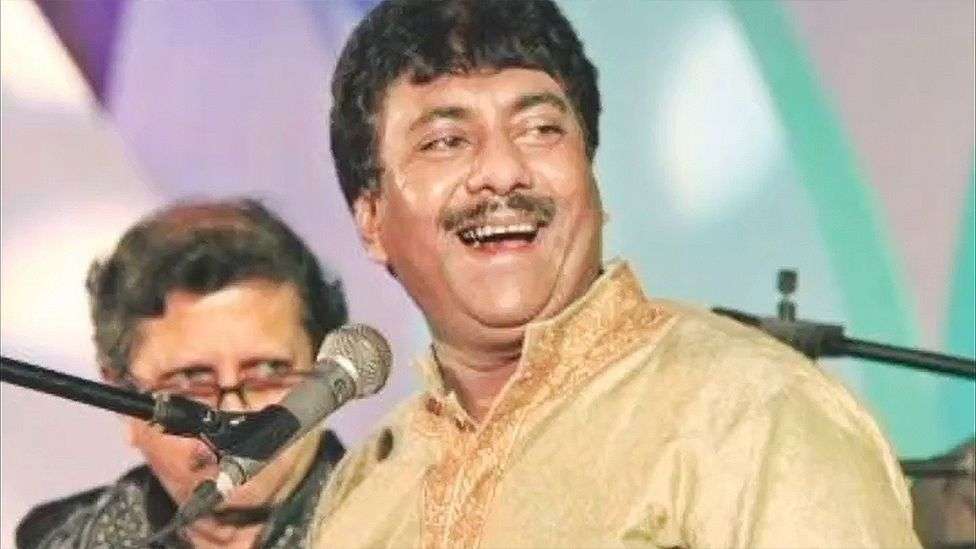The death of Indian music maestro Rashid Khan earlier this week was followed by an outpouring of grief on and off social media.
The 55-year-old singer died in a hospital in Kolkata (formerly Calcutta) on Tuesday after a prolonged battle with cancer. He was buried with state honours two days later.
Sporting a mop of tousled salt-pepper hair and often dressed in bright floral shirts and kurtas, Rashid Khan didn't exactly carry the air of a traditional musical ustaad (maestro).
But he was, undisputedly, the defining artist of his generation, someone who enjoyed a kind of commercial success and public adulation that was rare for a classical singer of his era.
He commanded the biggest fee among his contemporaries and performed in packed auditoriums: in his busiest years, he was doing 20 concerts a month.
His untimely death has robbed India of one of its finest and most popular vocalists. The appeal of his khayal - a major form of north Indian classical music - cut across musical hierarchies, becoming a rare converging point for common people and the pundits.
Born in Badayun town of Uttar Pradesh state to a lineage of heredity music practitioners of the Rampur Sahaswan Gharana (musical lineage), Rashid was self-admittedly not very interested in music until his late teens.
His guru and maternal grand-uncle, Ustad Nissar Hussain Khan, was an exacting teacher and would make him repeat a single note pattern all day long. Hours of practice and the repetitive rigour that went into honing this difficult art form didn't sit well with his rebellious, fun-loving personality.
It was only when young Rashid was brought into the hallowed grounds of the ITC Sangeet Research Academy, an exclusive music conservatory in Kolkata, that he really began enjoying his training, absorbing ideas and influences from the stalwarts who lived there.
Gifted with a melodious voice, it didn't take him very long to win plaudits. After the death of his guru in the 1990s, there was a void in performers who sang the Rampur style and Rashid swiftly filled it, storming the concert scene with flattering endorsements of his talent from the likes of Pandit Bhimsen Joshi. The great maestro once said the future of north Indian classical music rested safely in Rashid's singing.
"But even after gaining mainstream success, Rashid continued to live life on his own terms, without a care for the world," said renowned sitar player Ustad Shujaat Hussain Khan. He was a man who "mainly spoke in grunts, sighs and nods", a musician who did not realise his genius, and a performer who "just got up and started singing".
"But when he sang, you realised the greatness of his talent."
While trained within the confines of Rampur style - which focused on intricate rhythmic play, fast elaborations and a full-throated throw of voice - Rashid, like most greats, transcended its boundaries. Slow tempo melodic elaborations that had a strong emotive emphasis became the insignia of his performances.
"He refused to be boxed in or be bound by convention," Shailaja Khanna, his old friend and music critic, told the OceanNewsUK.
According to Shubha Mudgal, a noted vocalist, Rashid borrowed generously from the different styles of pathbreaking musicians such as Ustaad Amir Khan and Ustaad Bade Ghulam Ali Khan, "but chose not to imitate them".
"It was his unorthodox approach to music that led him to finding his own voice," Mudgal added. That, along with "an irrepressible urge to be himself artistically", is what created some of the magic.
In his 2004 book, Khayal Vocalism, noted music expert Deepak Raja called him the "prince of modernism" who showed complete respect to classical forms but didn't hesitate to "blur the distinctions between mainstream genres".
Which perhaps explains why Rashid became a prolific collaborator, and added different styles of singing to his performing repertoire. He didn't believe in the hierarchies imposed by puritans. And it was this willingness to lend his voice to a variety of semi-classical forms "that led to his gaining a mammoth audience", says Mudgal.
For listeners, it was Rashid's ability to stir profound exclamations - of love, devotion and reverence - that set him apart. Hearing him sing was a beautiful surprise, as he would switch between the lyrical and soft, before suddenly bursting into an intricate taan - the technique of improvising with rapid melodic passages.
The lover's lament "Yaad piya ki aaye" - once immortalised by Ustaad Bade Ghulam Ali Khan - was one of the most requested pieces of music in a Rashid concert. And he was also open to including his Bollywood hits like "Aoge jab tum o saajna" in a classical performance.
The puritans didn't approve of this. Critics also complained that Rashid didn't really explore the rare ragas of the Hindustani classical repertory, and could at times, sound mechanical in his performances as he was constantly juggling multiple concerts.
"But he managed to satisfy the demanding, orthodox listeners as well as those who came to listen to the singer they had heard in a film," says Mudgal.
He also captivated the masses by creating a "regal ambiance" to his concerts, says Khanna. A big presence on stage, he was always surrounded by fellow musicians accompanying him on instruments like the harmonium and the three-stringed sarangi, and a jamboree of vocalists providing the drone of the tanpura. It immediately transported people into another realm.
As a fan put it, at a Rashid concert, one could feel the audience singing along in their heads, or rather wishing they could.
His contemporary, singer Ashwini Bhide Deshpande remembers being completely entranced by one of his performances in the early 2000s.
"His exquisite exposition of Raag (melody) Jog - a night melody - didn't leave me for three days. His music elevated people's spirits, and soothed their souls There are many who play to the gallery by displaying histrionics. But Rashid's singing had an emotional depth that is hard to find," said Bhide.
"It's a huge loss to the music world," she adds. "He now joins the pantheon of greats from a bygone era, who were endowed with that rare gift to bring a raga (melody) alive."
The many students under his tutelage, including son Armaan now carry the giant responsibility of taking his musical legacy forward. "But there's no one who can replace him, at least in the immediate future," said Khanna.
But those who knew Rashid personally say he was a man who tread lightly. Perhaps his death was a mirror to the life he lived and the music he created:
"He came, enthralled generations with his singing, and then just got up and left," Shujaat Khan said. "Maybe that's just how we should remember him too."








